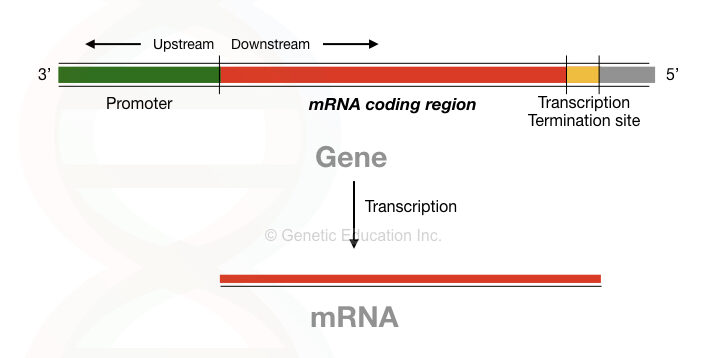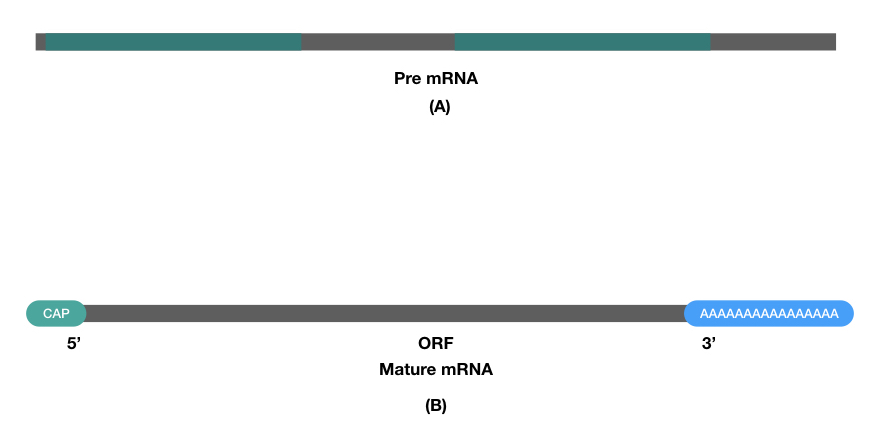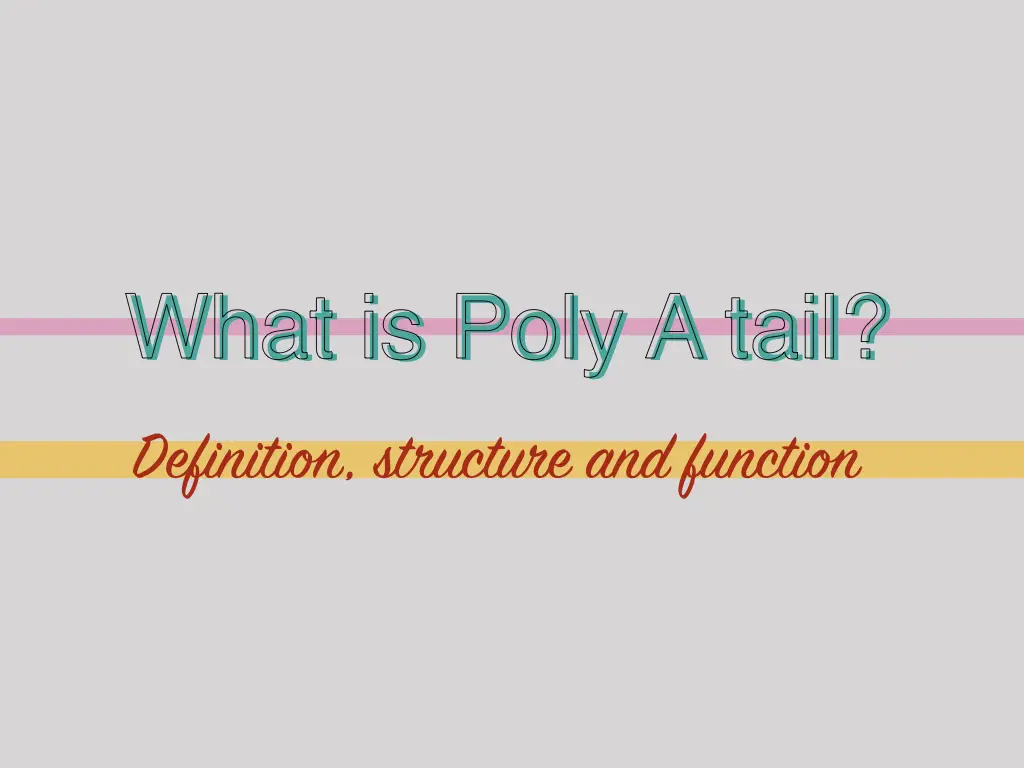“Poly-A tail is a long chain of adenine nucleotides added to the 3’ end of the mRNA after the transcription and makes the mRNA stable and free from degradation.”
Poly A tail plays a vital role in gene expression for both prokaryotes as well as eukaryotes. It converts the primary mRNA transcript to the mature mRNA and therefore it is important for translation to occur.
Genes make protein via a three-step process, collectively known as central dogma processing, a combination of replication, transcription and translation.
A process of replication governed by the DNA polymerase forms copies of a gene or duplicate genes or DNA. RNA polymerase forms the functional mRNA through transcription and finally a protein product forms by translation of mRNA.
Notably, not all three occur in a nucleus, the replication and transcription occur in a nucleus while translation occurs in the cell cytoplasm.
The process is known as “RNA processing” is essential to protect the mRNA. The transcribed mRNA is known as “transcript”- having information only to encode a protein.
mRNA without processing- known as pre-mRNA can’t form protein or abrupt protein product forms, henceforth mRNA processing such as 5’ capping and addition of Poly A tail on the 3’ end is required.
The present piece of content concentrates on Poly A tailing of mRNA. The present article is a bit in-depth and technical still I will try to explain it to you. We will discuss the structure, function, and importance of Poly A tail.

Key Topics:
What is Poly A tail?
The process, known as adenylation, governed by the enzyme Poly-A polymerase forms the poly-A tail at the terminal end of the mRNA.
mRNA is among various types of RNA molecules whose building blocks are nucleotides- A, U, G, C. mRNA is a messenger RNA having a massage to form a protein, in layman. The other two main types of RNA- tRNA or transfer RNA and rRNA or ribosomal RNA helps in this process.
Related article: RNA structure and function.
Theoretically, the mRNA consists of only the coding portion (introns are removed) that translates protein after exporting to the cytoplasm. But unfortunately, the mature mRNA has to face several problems during this process. Enzymes in the cytoplasm may degrade it and truncated, abrupt or abnormal protein forms or even can’t form any protein.
RNA processing protects mature mRNA from both the ends by modifying it, Poly A tail is one the modification prevents rapid degradation. Regulates gene expression, consequently.
Definition:
Poly A tail is a long chain of adenine, formed by polyadenylation by the enzyme poly-A polymerase which helps in exporting, maintaining and protecting the mature mRNA.
Structure:
After completion of transcription, various proteins and enzymes help mRNA for protein translation. Structurally, the mature mRNA (having the Poly A tail) is not much different from the pre mRNA.
It is a single-stranded chain of nucleotides, shorter than a gene having a 5’ cap and 3’ Poly A tail. The structure of mature mRNA and the difference between pre- mRNA and mRNA is shown in the figure below,

Process of adenylation:
The initiation of post-transcriptional poly-adenylation starts when various proteins, enzymes and sequence elements come into action.
The process of adenylation begins when multiple proteins such as CPSF, SctF, PAP, PABII, CFI and CFII start the catalytic activity. Here the CPSF cleaves the 3’ end to adenylate.
All these activities start at the terminal of the transcription when the mRNA or more precisely say, pre-mRNA forms. After that, the Poly-A polymerase came into action to start the polyadenylation process.
PAS sequence (polyadenylation signal) sequences- AAUAAA and GU-rich sequences on the mRNA govern the process of adenosine chain formation.
The polymerase adds 100 to 250 adenine (adenosine monophosphate) at the end of the 3’ end and removes the pyrophosphate. Note that the process of Poly A tailing also occurs in the microRNAs as well.
In the prokaryotes, the poly-A tailing leads to the degradation of mRNA to regulate the gene expression.
The normal range of the poly-A tail adding; is 100 to 150 adenosine but! Interestingly, studies reveal that different lengthed genes have a variable poly-A tail. Some are very short while some are long.
The length of the tailing also varies in different organisms as well, for example, humans and other related eukaryotes have longer, around 100 to 150 nucleotides long Poly A tail while yeast has comparatively shortened, up to 33 adenosines in their poly-A tail.
Still, protein synthesis and gene regulation happen in a controlled manner. So the question that arises in mind is that, is the length of poly-A tail important for the most of post-transcriptional or translational activity?
There is no clear data and scientific evidence that answers this question correctly.
Nonetheless, recent studies show that the longer poly-A tail leads to poor translation of low abundance transcript while the shorter poly-A tail leads to correct translation and tightly regulates gene expression.
These shocking findings suggest that those genes which are tightly regulated, have comparatively shorter poly-A tail than the genes having abnormal expression.
Instead of the fact that the shorter adenine tail is more prone to degradation, it allows more gene expression.
Findings contradict the previous facts that the longer poly-A tail protects and regulates mRNA transcription more correctly than the shorter one!
Another important finding that supports the present finding is that unprotected adenosines are removed faster from the tail than the protected ones. Here during the nucleus to cytoplasm transportation, proteins like PABPC and PABPN cap the poly-A tail and protect it.
Though the role of either protein is yet not clear, uncapped adenosines from the poly-A tail removes at a faster rate. Neither the length of the poly-A tail nor the length of a gene is responsible for deadenylation, instead, the role of other proteins that protect the poly-A tail decides the rate of deadenylation henceforth the length of the tail.
Moreover, the process of Guanylation and Uridination also regulates the length of the poly-A tail.
The process of polyadenylation occurs dedicatedly in the nucleus of the cell while the deadenylation occurs in the cytoplasm of a cell by the dedicated exonuclease (exonuclease cleaves DNA outside).
The length of the poly A tail decides the stability of the mRNA, larger the poly A tail, more stable the mRNA is, because deadenylation in that case takes more time. Adenylation work as a stabilizing agent for the mRNA, henceforth.
Deadenylation:
Much like the adenylation of mRNA, the process of deadenylation is also important to cleave the mRNA. It occurs in the cytoplasm where a dedicated exonuclease starts shortening the polyA tail.
Other enzymes like the PNPases also help in this process. Once the poly-A tail is removed through deadenylation, the mRNA undergoes decay by the 3’ to 5’ exonuclease.
Function:
As we said, the poly-A tailing process at 3’ end, as well as 5’ capping, plays vital roles in the export, translation and stability of mRNA. The main function of post-transcriptional modifications is to promote and regulate gene expression.
Nucleases present in the cytoplasm cleaves mRNA, especially the exonuclease. Fortunately, the poly A tail is the binding site for many of the proteins that prevent cleaving of mRNA and transports mRNA safely to the cytoplasm.
Along with the poly-A tail and binding protein, it transfers to the cytoplasm and initiates the process of translation. Though the Poly A tail is not directly involved in the process, sometimes it helps in the binding of some proteins that are implicated in the translation, for example, initiator factor-G. Cleaving of mRNA is very important for the transport of mRNA from the nucleus to the cytoplasm.
Importance of poly-A tail:
As we explained the main function of tailing by insertion of adenosines at the 3’ end of the mRNA is to protectively transport the mRNA to the cytoplasm. More to this, the role of the tailing process is to regulate gene expression.
When a gene forms a protein through transcription and translation, it is said as expressed. The gene activates and forms proteins when it is needed. Henceforth, it is very important for the cell mechanism to regulate the amount of protein form in a particular cell or tissue.
Poly A tail protects mature mRNA degradation and leads to translation, thereby; if the tail isn’t successfully formed or adenylation doesn’t happen, the mRNA can’t manufacture a protein.
In addition to this, abrupt or truncated poly-A tail fails to transport the transcript to the cytoplasm, ultimately, resulting in untranslated. It also facilitates binding sites for many proteins, factors and enzymes for translation to occur.
Detection of polyadenylation or Poly A tail:
As we explained so far, the process of tailing at the 3’ end is important for proper and efficient transportation and translation of mRNA. Therefore, measuring its activity helps to understand the process.
The G/I- adenosine and inosine mediated reverse transcription amplification method efficiently detect the poly-A tail of mRNA. The process is simply explained here.
In the first step, the addition of polymerase (poly-A tail specific) adds guanosine and inosine residues to the poly-A tail of mRNA.
Soon after, using the reverse transcriptase, the mRNA having the poly-A and the residues of GI are converted into the cDNA.
Two sets of amplification primers are used to detect the produced, one set amplifies the gene of study, upstream to the poly-A tail and the second set of primer with the universal reverse primer amplifies the poly-A tail containing region.
Agarose gel electrophoresis or PAGE separates and detects the amplification products.
Besides, the qPCR assay quantifies the Poly A tail and mRNA.
Transcript analysis:
I know that transcript analysis is not a part of this topic, but to clarify the present topic, we need to study it.
The transcript is our mature mRNA from which a protein would form. Abrupt mRNA can’t form a correct protein. In order to understand the nature of RNA processing and poly-A tail, quantification of gene expression helps.
If we know how much mRNA is expressed, we can determine the activity of polyadenylation and deadenylation.
Q (RT) PCR and microarray are two techniques that quantify different mRNA present in the sample.
The quantitative reverse transcription PCR first converts the mRNA into the cDNA and quantifies it.
The microarray measures gene expression through probe base hybridization. If you want to learn more on the present topics, please read the previous article: What is transcriptomics?
Conclusion:
Note that the above process, facts and explanations concentrate only on the mammalian poly-A tail and associated processing. Bacterial and other prokaryotes may have a different mechanism.
For example, the poly-A tailing in E Coli induces degradation of mRNA, rather than stabilizing it.
Poly A tail and capping at 5’ end are important events or post-transcriptional processing required to correct translation. However, the mechanism, exact role and processing of the poly-A tail is yet not explained.
Sources:
Nicholson AL, Pasquinelli AE. Tales of Detailed Poly(A) Tails. Trends Cell Biol. 2019;29(3):191-200. doi:10.1016/j.tcb.2018.11.002
Dreyfus M and Regnier P. The poly (A) tail of mRNAs – bodyguard in Eukaryotes, Scavenger in Bacteria.The cell. 2002;111(5)- 611-613.
Subscribe to our weekly newsletter for the latest blogs, articles and updates, and never miss the latest product or an exclusive offer.



